
Looney Tunes is an American media franchise produced and distributed by Warner Bros. The franchise began as a series of animated short films that originally ran from 1930 to 1969, alongside the related series Merrie Melodies, during the golden age of American animation. Following a revival in the late 1970s, new shorts were released as recently as 2014. The two series introduced a large cast of characters, including Bugs Bunny, Daffy Duck, and Porky Pig. The term Looney Tunes has since been expanded to also refer to the characters themselves.

Merrie Melodies is an American animated comedy short film series distributed by Warner Bros. Pictures. It was part of the Looney Tunes franchise and featured many of the same characters. It originally ran from August 2, 1931, to September 20, 1969, during the golden age of American animation, though it was revived in 1979, with new shorts sporadically released until June 13, 1997. Originally, Merrie Melodies placed emphasis on one-shot color films in comparison to the black-and-white Looney Tunes films. After Bugs Bunny became the breakout character of Merrie Melodies and Looney Tunes transitioned to color production in the early 1940s, the two series gradually lost their distinctions and shorts were assigned to each series randomly.

Bugs and Thugs is a 1954 Warner Bros. Looney Tunes cartoon directed by Friz Freleng. The short was released on March 13, 1954, and stars Bugs Bunny, with Rocky and Mugsy. The film is a semi-remake of the 1946 cartoon Racketeer Rabbit. It is also the first Warner Bros short to feature Milt Franklyn as a musical director.

Rhapsody Rabbit is a 1946 American animated comedy short film in the Merrie Melodies series, directed by Friz Freleng and featuring Bugs Bunny. The movie was originally released to theaters by Warner Bros. Pictures on November 9, 1946. This short is a follow-up of sorts to Freleng's 1941 Academy Award-nominated Rhapsody in Rivets, which featured the "Hungarian Rhapsody No. 2" by Franz Liszt. The "instrument" used to perform the "Hungarian Rhapsody" in Rhapsody in Rivets is a skyscraper under construction, while this short features Bugs playing the piece at a piano while being pestered by a mouse.
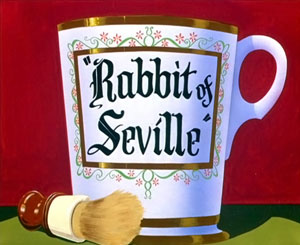
Rabbit of Seville is a Warner Bros. Looney Tunes theatrical cartoon short released on December 16, 1950. It was directed by Chuck Jones and written by Michael Maltese, and features Bugs Bunny and Elmer Fudd. The nonstop slapstick humor in the short is paced musically around the overture to Italian composer Gioachino Rossini's 1816 opera buffa The Barber of Seville. In 1994, Rabbit of Seville ranked number 12 in a list of "The 50 Greatest Cartoons" released in North America during the 20th century, a ranking compiled from votes cast by 1,000 artists, producers, directors, voice actors, and other professionals in the field of animation.
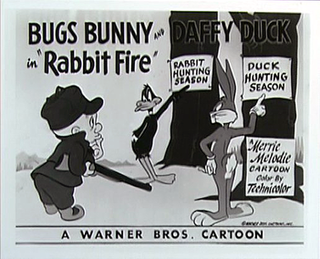
Rabbit Fire is a 1951 Looney Tunes cartoon starring Bugs Bunny, Daffy Duck, and Elmer Fudd. Directed by Chuck Jones and written by Michael Maltese, the cartoon is the first in Jones' "hunting trilogy"—the other two cartoons following it being Rabbit Seasoning and Duck! Rabbit, Duck! It is also the first cartoon to feature a feud between Bugs and Daffy. Produced by Edward Selzer for Warner Bros. Cartoons, the short was released to theaters on May 19, 1951 by Warner Bros. Pictures and is often considered among Jones' best and most important films.
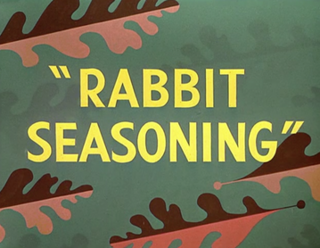
Rabbit Seasoning is a 1952 Warner Bros. Merrie Melodies cartoon directed by Chuck Jones. Released on September 20, 1952, the short stars Bugs Bunny, Daffy Duck and Elmer Fudd.

Bugs Bunny and the Three Bears is a 1944 Merrie Melodies cartoon short directed by Chuck Jones and written by Tedd Pierce. The short was released on February 26, 1944, and features Bugs Bunny. This short marks the first appearance of Jones' dysfunctional version of The Three Bears, and is a parody of the old fairy tale, Goldilocks and The Three Bears.

Transylvania 6-5000 (1963) is a Warner Bros. Merrie Melodies animated short directed by Chuck Jones. The short was released on November 30, 1963, and stars Bugs Bunny.

Slick Hare is a 1947 Merrie Melodies cartoon, directed by Friz Freleng. The film was released on November 1, 1947, and features Bugs Bunny and Elmer Fudd. It parodies the Mocambo nightclub in Los Angeles—in the cartoon referred to as "The Mocrumbo". Mel Blanc voices Bugs, Arthur Q. Bryan voices Elmer Fudd and impressionist Dave Barry portrays Humphrey Bogart. The title is a pun on "hair", from an era when hair slicked down by oil was a popular fashion style for men.

Haredevil Hare is a 1948 Looney Tunes cartoon directed by Chuck Jones. It stars Bugs Bunny and it is the debut for Marvin the Martian — although he is unnamed in this film—along with his Martian dog, K-9. Marvin's nasal voice for this first film is different from the later one he is most known for. This is also the last pre-August 1948 Looney Tunes and Merrie Melodies cartoon whose distribution rights were sold to Associated Artists Productions.

14 Carrot Rabbit is a 1952 Warner Bros. Looney Tunes animated cartoon short directed by Friz Freleng. The short was released on March 15, 1952, and features Bugs Bunny and Yosemite Sam. The title is a play on "14 karat", as in a purity level for gold.
Beanstalk Bunny is a 1955 Warner Bros. Merrie Melodies cartoon directed by Chuck Jones. The short was released on February 12, 1955, and stars Bugs Bunny, Daffy Duck and Elmer Fudd. The cartoon's story is derived from the fairy tale "Jack and the Beanstalk".

Lighter Than Hare is a 1960 Warner Bros. Merrie Melodies animated short written and directed by Friz Freleng. The short was released on December 17, 1960, and stars Bugs Bunny and Yosemite Sam. The title is a play on the phrase lighter than air. It was one of three Bugs cartoons that Freleng both wrote and directed, the others being From Hare to Heir (1960) and Devil's Feud Cake (1963).
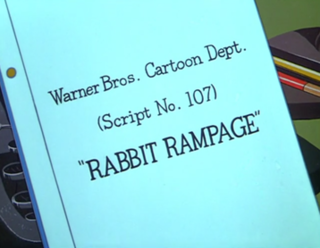
Rabbit Rampage is a 1955 Warner Bros. Looney Tunes animated cartoon, directed by Chuck Jones. The short was released on June 11, 1955, and stars Bugs Bunny.

Person to Bunny is a 1960 Merrie Melodies animated cartoon directed by Friz Freleng. The short was released on April 1, 1960, and stars Bugs Bunny, Daffy Duck and Elmer Fudd. It is the last cartoon to feature Arthur Q. Bryan as the voice of Elmer, and was released shortly after Bryan's death.

Baton Bunny is a 1959 Warner Bros. Looney Tunes cartoon, directed by Chuck Jones and Abe Levitow. The short was released on 10 January 1959, and stars Bugs Bunny.

Shishkabugs is a 1962 Warner Bros. Looney Tunes animated short directed by Friz Freleng. The short was released on December 8, 1962, and stars Bugs Bunny and Yosemite Sam. The title of the short is a play on shish kebab, a culinary dish.
This is a listing of all the animated shorts released by Warner Bros. under the Looney Tunes and Merrie Melodies banners between 1940 and 1949.
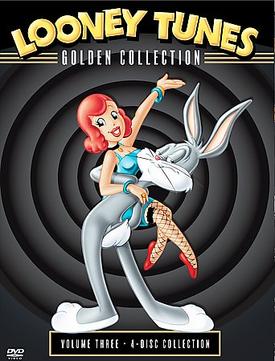
Looney Tunes Golden Collection: Volume 3 is a DVD box set from Warner Home Video that was released on October 25, 2005. It contains 60 Looney Tunes and Merrie Melodies theatrical short subject cartoons, nine documentaries, 32 commentary tracks from animators and historians, 11 "vintage treasures from the vault", and 11 music-only or music-and-sound-effects audio tracks.


















